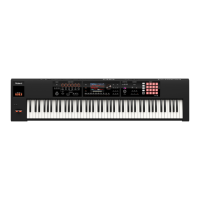Deutsch Français Italiano Español Português NederlandsEnglishEnglish
Selecting a Tone
Synthesizer (Performing)
1. Press a tone button.
2. Turn the dial to select the tone you want.
Play the keyboard.
MEMO
• While you hold down the [PREVIEW] button, this unit will play
a demo using a phrase that’s appropriate for the selected tone.
• If you press the [ENTER] button, the TONE LIST screen appears.
Here you can choose a tone from the list.
About the types of tone
This unit has SuperNATURAL tones and PCM tones.
SuperNATURAL tone
Type Explanation
SuperNATURAL
acoustic tones
(
)
These tones reproduce not merely the
sounds of acoustic instruments, but also the
dierences arising from the phrase, chord, or
melodic performances of the player, giving you the
expressive power that is distinctive of that acoustic
instrument.
SuperNATURAL
synth tones
(
)
Each tone components: OSC (oscillator), FILTER
(lter), and AMP (amp). Powerful synth sounds can
be produced by a single tone.
SuperNATURAL
drum kits
(
)
These are drum sounds that reproduce the natural
tonal change from soft to strong strikes, and the
way in which the sound responds to repeated
strikes.
PCM tone
Type Explanation
PCM synth tones
(
)
These are sounds that were called “patches” on
Roland synthesizers of the past, and have been
tuned for this unit. You can combine up to four
partials (waves) in one PCM synth tone.
PCM drum kits
(
)
These are sounds that were called “rhythm sets”
on Roland synthesizers of the past, and have been
tuned for this unit. A drum kit is a group containing
multiple percussion instrument sounds so that
dierent percussion instrument sound are heard
depending on the key (note number) you play.
About the screen
7
3
5
4
6
1
2
8
Number Explanation
1
Eect information and status
2
Song information
3
Bank, number, and name of the studio set
4
Tone number and name
5
Type and bank of tone
6
Tone level
7
Category name
8
Keyboard status (active region, dual, split, etc.)
Save your selection
Your selection of tone is temporary. If you turn o the
power or choose a dierent studio set, your tone selection
disappears. If you want this unit to remember the tone you
selected, save the studio set (p. 18).
You can add tones
A wide range of tones from the Axial sound library site can be added to this unit.
For details, refer to the Axial site.
http://axial.roland.com/
Category group Explanation
DRUMS/PERCUSSION Rhythm instruments
A. PIANO/E. PIANO Piano
KEYBOARD/ORGAN Keyboard/organ
BASS/SYNTH BASS Bass
GUITAR/PLUCKED Guitar
STRINGS/ORCHESTRA Strings/orchestral
BRASS/WIND Brass/woodwinds
VOCAL/CHOIR Vocal/choir
SYNTH/PAD Synthesizer/pads
FX/OTHER Sound eects/other
11

